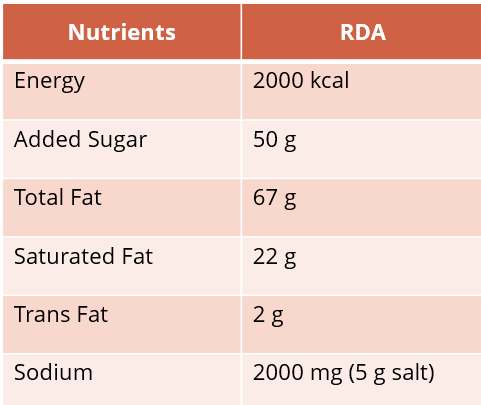What Does % Daily Value Mean?
July 20, 2022

Packaged food products appear to have all the printed information which is believed to provide all the valuable information to sustain life. The Little Box of Nutrition table at the back of the packaged foods strives to say about the food held within that package. At the top of the Nutrition table, the number of total servings of food or beverage present in the container and also the serving size of the respective food is mentioned. The serving size here means the amount of food or drink which is typically consumed at a time by the people and it does recommend how much to consume that product.
The rest of the nutrition table consists of product-specific information (calories and nutrient information) which is based upon the serving size or per 100 grams of that packaged food. To the unknowing eye, the bottom part of the table consists of a footnote that appears to be plain and difficult to comprehend. The footnote explains the Daily % Value and gives the number of calories used for general nutrition advice. Have you ever wondered what exactly this Percent Daily Value mentioned across each nutrient means?
What is the% Daily Value?
The Daily Values are reference amounts (expressed in grams, milligrams, or micrograms) of nutrients to consume or not exceed each day.
The % Daily Value is simply a guide to know how much of the RDA (Recommended Dietary Allowance) of a specific nutrient is supplied per serving of a particular food and beverage. The Recommended Dietary Allowance signifies the recommended Daily Intake of a particular nutrient that should be consumed daily to lead a sustainable healthy life.
For example: If the RDA for calcium is 1300mcg and a packaged food or beverage has 130 mcg in one serving, the percent Daily Value for Calcium per serving of that product would be 10%. That means If you consume one serving of that food product you would supply 10% need of calcium in a day and would consume other foods to get the other 90%.
Nutrition Labelling Guidelines
FSSAI has mandated the declaration of per serve percentage (%) contribution to Recommended Dietary Allowance calculated on the basis of

How does it help the consumers?
The % Daily Values are given either per serving size or for the whole container of the food product or it is given in both formats. It guides you to know whether the food product is High or Low in a specific Nutrient.
The General Guideline to know if the food product is high or low in nutrients is as follows:
5% Daily Value or less of a nutrient per serving is considered low.
20% Daily Value or more of a nutrient per serving is considered high.
It gives the consumers an idea to make informed choices by comparing the % Daily Value between various nutrients for that particular food product. So if you want to consume less of a nutrient (such as Saturated Fat, Sodium, and Added Sugars) choose a product with 5% or less DV for these nutrients.
If you want to consume more healthy nutrients (such as Dietary Fibre, Vitamin D, Calcium, Iron, and Potassium) choose food products with 20% or more DV for these specific nutrients).
% Daily Values also allows you to Understand Nutrient claims made for food products.
For example, if a food product claims to be low in Sodium. You do not need to check the definition for low sodium, simply check the %Daily Value for foods and compare it with other foods of the same category to see which one is higher or lower in that nutrient. Hence comparing %Daily Values one is able to make healthy dietary choices.
Also Read - How To Understand Serving Size On A Food Label?
References:
Daily Value on the New Nutrition and Supplement Facts Labels.
https://www.fda.gov/food/new-nutrition-facts-label/daily-value-new-nutrition-and-supplement-facts-labels
Food Labelling: Revision of the Nutrition and Supplement Facts Labels. Final rule.
Food and Drug Administration, HHS. 2016 May 27.

Rashida Vapiwala (Founder at LabelBlind®, Food Label Specialist, Ph.D (Food Science and Nutrition))
Rashida is passionate about solving problems for the food industry using technology. She loves creating tech-led solutions in the space of Nutrition.
